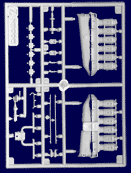1915 was a very successful year for the Kaiser's aviation. The arrival of the first true fighter, Fokker's E.III Eindecker, enabled the Germans to prevail for a long time in the skies of the Western Front. However, the nations of the Entente Cordiale soon began preparing for Germany a small but potent surprise in reply: the legendary Nieuport 11 Bébé, which appeared in 1916. This tiny biplane soon achieved dominance in its air battles and completely forced out Fokker's monoplanes from the sky.
During that period, when the main zone of aerial combat was at a height of 3,000 to 4,000 meters, the newest Fokker fighter the E.IV lost its advantage and became an easy victim for the Nieuports in spite of its powerful armament of two synchronized LMG.08 machine guns. At the same time, Idflieg (Inspectorate of Flying Troops) was talking to all the leading aircraft manufacturers, because of the urgent necessity of developing more advanced fighters. The success of the Nieuport convinced everybody that the biplane fighter design was the most promising, taking into account the relative power of the available engines, and also what was enquired for tight maneuvering in a duel at close quarters. By the spring of 1916, the first prototypes from the Fokker and Halberstadt firms were ready for testing. They greatly surpassed the performance of existing monoplanes; however, they still came up short in comparison with the Nieuport 11 Bébé.
Around that time, in April 1916 a radically new type was introduced by the Albatros Flugzeugwerke GmbH, which up until then had only produced two-seat multi-purpose airplanes (mostly reconnaissance and light bombing types). One of the main differences from the other competing designs was the powerful 160 hp engine of the Albatros D.I, while the Fokker and Halberstadt machines had 100 and 120 hp engines. Another innovation of the design was its fuselage. While other contemporary types had truss frames covered with linen, the Albatros D.I had a streamlined plywood construction (so-called "semi-monocoque"), which managed to be simple and strong at the same time. The powerful specification of the machine was completed by two synchronised Spandau machine guns, hidden under the smooth lines of the top panels.
The Albatros D.I reached a height of 4,000 meters during testing, in only 22 minutes, quicker than any other fighter. The speed and maneuverability of the new machine were more than satisfactory and it is not surprising that this development by designer Robert Thelen was viewed by the military as a great encouragement. In July of 1916 Idflieg recommended that the Albatros D.I be put into production. The order was for 50 machines, which was then the normal practice for the German Army; any new development was ordered in limited quantity (20-50 units), and its initial operational experience, and any failures, gave some guidance to the constructor as to the necessity for any improvement of the design, or else led to an increased order for the existing design.
Series production Albatros D.I's were given the serial numbers D.422/16-471/16. Taking into account the obvious success of the fighter, Idflieg issued an order for a second batch with the following numbers: D.472/16-521/16. However, production of the Albatros D.I remained in number only 50 machines, because a more modern version was ready; the Albatros D.II, which replaced it in the second batch.
The appearance of the Albatros D.I at the end of the summer of 1916 was a nasty surprise for the British and it was clear that their de Havilland DH2 had immediately lost its advantage. Allied aces such as James McCudden noted the outstanding capability of the Albatros D.I and gave due respect to its fighting prowess in the air.
In the fall of 1916, Jasta 2 under the command of famed ace Oswald Boelcke forced the air arms of the opposition to set about improving their own equipment. The active service of the Albatros D.I was quite short, because already at the end of 1916 it was being supplanted by the more modern Albatros D.II. However, some of the machines from the 50 produced in total, survived to the last year of the Great War as training planes.
- Albatros D.I (D.426/16), Lt. Günter, Jasta 2. Western front, Berthincourt, Autumn 1916.
- Albatros D.I (D.435/16), Lt. Spitzhoff, Jasta 5. Western front, Autumn 1916.
- Albatros D.I (D.390/16), Lt. O.Höne, Jasta 2. Western front, Berthincourt, Autumn 1916.
- Albatros D.I (w/n unknown). Flown by Rittmeister Prince Friedrich Carl von Preussen, FlAbt(A)258. Western front, March, 1917.
Performances:
- Wingspan upper: 850 mm
- Wingspan lower: 800 mm
- Length: 7.40 m
- Take off weight: 921.5 kg
- Time of 3000 m altitude reaching: 15 min
- Speed max: 165 km/h
- Engine: 1x160 hp Mercedes D.III
- Machine guns: 2xLMG 08/15 Spandau
















